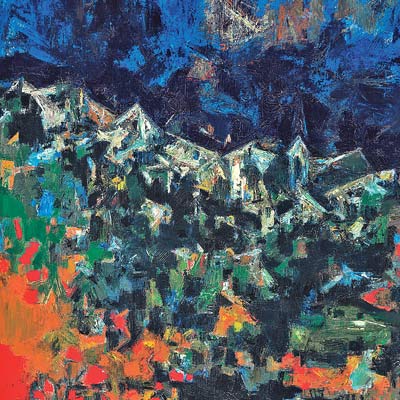
International recently, the renowned auction house revealed that sales of art and collectibles rose to a record US$ 4.6 billion, until July this year. London-based Christie’s, declared that this year 52 artworks have fetched more than US$ 10 million and 479 lots exceeded US$ 1 million from their worldwide sales rooms.
Rarity Sells
Some of the shattering records this year included a 1960 Joan Mitchell abstract painting, which sold for US$ 11.9 million at Christie’s, in New York in May—the highest ever for a work by a woman artist. Another record was established for conceptual British artist, Tracey Emin. Her controversial artwork ‘My Bed’, previously owned by the advertising mogul Charles Saatchi sold for £ 2.5 million on July 1, 2014 at Christie’s in London.
Countering Christie’s buoyant sales, was its historical competitor—Sotheby’s with a triptych by Francis Bacon from the1964-titled ‘Three Studies for Portrait of George Dyer’ (on Light Ground), which went under the hammer for US$ 45.4 million. Largely, these sky–high prices at auctions depend on rarity and artworks/pieces of historical importance, whereas the ground rules in the contemporary art market is more linked to expectations and the perception of what the market believes is going to be valuable in the future. It would be fair to state that prices of modern art, miniatures and rare objects at the very top end of the market have experienced an exponential rise in prices.
 S H Raza
S H Raza
Revival of Indian Art Mart
While in absolute terms, these sales and figures appear to be stupendous, this does not imply that all works at auctions necessarily command astronomical prices. The Indian art market is tipped at around US$ 100 million, which is miniscule compared with the West. Christie’s first-ever auction in India in December 2013, was a watershed point for Indian art. The highlight of the sale was an untitled 1979 work by Vasudeo S. Gaitonde, which sold for US$ 3.7 million, the highest price for any Indian artwork sold to date. This impressive auction was followed by successful sales by Indian auction houses Saffronart and Pundole’s Art Gallery. These sales appear to be signs of the revival of the Indian art market. Saffronart’s notable sale in Mumbai in February 2014 included a 1951 gouache on paper by eminent artist SH Raza titled “ Haut De Cagnes” which sold amid fierce competitive bidding at Rs 5.75 crore, the most expensive paperwork by an Indian artist ever sold at auction. Pundole’s March auction offered 91 lots, divided into Asian antiquities including a selection of 10th and 11th century’s figurines and works from artists from the Progressive Artists’ Group such as F N Souza and M F Husain the sale catered to the seasoned art collectors. Besides offering exceptional works by modern and contemporary artists for sale, Saffronart conducted an online auction of elegant design. This sale featured period furniture and collectibles, which included some rare art deco, colonial and silver pieces.
Debuts and Demands
Auction houses function as agents by offering works of art and collectibles for sale, at auction and by brokering private sales of high-value artwork. Unlike acquiring works from the primary market (galleries or directly from artists), auctions work on a simple principle – the work is sold to the highest possible bidder.
“I believe our mission is to present this art in India to an international platform through our sales and other engagements,” says Sonal Singh, Associate Director and Head of Department at Christie’s India. “The interest for Indian art is at a high level at the moment with the recently opened M.F. Husain exhibition at the Victoria & Albert Museum in London, the upcoming retrospective of Gaitonde’s work at the Guggenheim Museum in New York and the Kochi Muziris Biennale, which enjoyed an international recognition two years ago when it was staged for the first time”.
The art market can be affected by the uncertainty around fakes and forgeries, speculators ‘flipping’ art works and by global economic factors, but with the growing number of billionaires in India and an expanding base of international buyers for Indian art combined with the increasing demand for high-quality and rare works with impeccable provenance, the art market will continue to grow. Given the strength of demand, an interest across categories and a renewed confidence, according to experts, expectations for the second half of 2014 auction sales season are high.
(Farah Siddiqui is a Mumbai-based art consultant.)